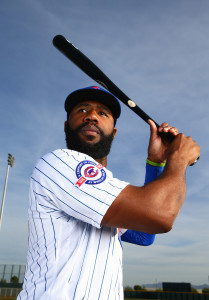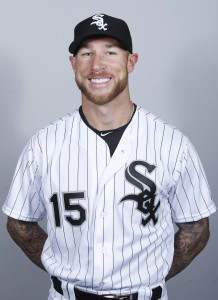Check out all the published entries in our Offseason in Review series here.
The Cubs added tons of veteran talent to an already-strong team, mostly through free agency.
Major League Signings
- Jason Heyward, RF: eight years, $184MM. Heyward can opt out after 2018 season or after 2019 season with 550 plate appearances in 2019. Includes deferred money.
- Ben Zobrist, 2B: four years, $56MM
- John Lackey, SP: two years, $32MM
- Dexter Fowler, CF: one year, $13MM. Includes $9MM mutual option for 2017 with a $5MM buyout.
- Trevor Cahill, RP: one year, $4.25MM
- Andury Acevedo, RP: one year, $700K. Split contract, worth $200K in minors.
- Total spend: $289.95MM.
Notable Minor League Signings
- Aaron Crow, Stephen Fife, Brandon Gomes, Jean Machi, Edgar Olmos, Jack Leathersich, Manny Parra, Jonathan Pettibone, Tim Federowicz, Jesus Guzman, Munenori Kawasaki, Kristopher Negron, Matt Murton, Juan Perez, Shane Victorino
Trades And Claims
- Claimed RP Ryan Cook off waivers from Red Sox (Cubs non-tendered Cook on December 2nd)
- Claimed RP Jack Leathersich off waivers from Mets (Leathersich elected free agency and was signed to a minor league deal by the Cubs in December)
- Acquired RP Spencer Patton from Rangers for 2B Frandy De La Rosa
- Claimed RP Edgar Olmos off waivers from Mariners (Olmos claimed by Orioles from Cubs on December 10th, (claimed back by Cubs on December 23rd, outrighted by Cubs in February)
- Acquired RP Rex Brothers from Rockies for P Wander Cabrera (Cubs released Brothers on March 10th)
- Acquired P Adam Warren and IF Brendan Ryan from Yankees for 2B Starlin Castro (Cubs released Ryan on December 23rd)
- Claimed RP C.J. Riefenhauser off waivers from Orioles
- Acquired P Aaron Brooks from Athletics for OF/2B Chris Coghlan
Notable Losses
- Starlin Castro, Chris Coghlan, Frandy De La Rosa, Wander Cabrera, Chris Denorfia, Jonathan Herrera, Dan Haren, Jason Motte, James Russell, Tsuyoshi Wada, Tommy Hunter, Fernando Rodney
Needs Addressed
Entering the offseason, it was no secret that the Cubs had a middle infield surplus with Addison Russell, Javier Baez, and Starlin Castro. With four years and $38MM remaining on his contract, Castro was the most likely to go. The Yankees were a natural match, having shown interest in Castro during the summer. As Yankees GM Brian Cashman told John Harper of the New York Daily News, the Cubs initially asked for outfielder Brett Gardner and were rebuffed. Then, after a month of the Cubs pestering Cashman for swingman Adam Warren, the Yankees gave in and the trade agreement was reached. Still, the Castro trade was delayed for a few days, as the Cubs were simultaneously attempting to sign Ben Zobrist as a free agent.
The Cubs achieved Theo Epstein’s “multiple-bank shot,” moving on from Castro after six big league seasons. I was surprised by the Cubs’ plan to move Castro to make room for a second baseman from outside the organization. Instead of plugging Baez in at second base, the Cubs went with veteran Ben Zobrist, who turns 35 in May. Zobrist served as Joe Maddon’s Swiss Army knife for six seasons after establishing himself in the Majors with the Rays. While Zobrist may not be the defensive asset he once was, he’s still an excellent high-contact hitter and potential three-win player. The Cubs should get good value with Zobrist at $14MM a year, despite the riskiness of signing a player through age 38. He’s a clear improvement over Castro, and with the Yankees taking on Castro’s contract, two-thirds of Zobrist’s deal is covered. The Cubs can rest assured that competition was stiff for Zobrist, with the Mets and Giants willing to go to $60MM and the Nationals making a play.
With the addition of Warren, the Cubs proved that Castro did indeed have mild positive trade value despite the middle infielder’s contract and up-and-down career. In Warren, the Cubs received a useful pitcher who is under club control for three years. The 28-year-old can serve as an effective reliever or credible fifth starter depending on the Cubs’ needs.
The Cubs’ primary offseason need was to add an impact starting pitcher. Though Epstein later told WEEI the Cubs were “very interested” in the best available option, free agent David Price, the Cubs’ president also admitted, “We ended up a distant third” in the bidding. Shortly after Price’s agreement with the Red Sox, the Cubs reached an agreement 37-year-old veteran starter John Lackey on a two-year deal. Epstein had previously signed Lackey as Red Sox GM six years prior. As Epstein explained in that same WEEI interview, “There’s risk inherent in longer pitching contracts, and having a pitcher the caliber of John Lackey on a two-year deal was a no-brainer for us.” I thought Lackey would command a three-year deal even at his advanced age and with a qualifying offer attached, so plucking him from the Cardinals on a two-year term was a big win.
By the Winter Meetings, the Cubs had made significant improvements to an already-strong club, without surrendering prospects or adding a major financial burden (at least for a big-market team). Soon, it became apparent the Cubs’ biggest move was yet to come. They were again tangling with the Cardinals and Nationals for a free agent: Jason Heyward. We’ll have more on the Heyward signing in the Deal Of Note section.
With the Cubs adding Zobrist, Lackey, and Heyward, the rich got richer. Heyward was penciled in at a new position, center field, since Dexter Fowler was expected to sign elsewhere as a free agent and the Cubs already had Jorge Soler as the right field incumbent. It appears that the Cubs kicked around a lot of trade possibilities, likely involving Soler and Baez. Meanwhile, the team quietly re-added Trevor Cahill on a one-year deal. Cahill turned down a more definitive rotation offer from the Pirates to stay with the Cubs, even though he seems likely to begin the year in the bullpen. Cahill’s contract calls for incentives both for starts and relief appearances. The 28-year-old first joined the Cubs in August on a minor league deal. He pitched for the big league club in September and after a dominant month out of the pen became a key late-inning reliever in the playoffs. The signing gives the Cubs four potential swingmen, along with Warren, Clayton Richard, and Travis Wood.
As February came to a close, the Cubs’ offseason seemed to have reached a successful conclusion, as they were down to tinkering with free agents on minor league deals. Then, in the course of a few hours, Epstein stunningly completed another multiple-bank shot. First, news broke that outfielder Chris Coghlan, whose presence on the Cubs’ roster was already somewhat redundant, had been traded to Oakland for Aaron Brooks. This trade seemed mostly about clearing Coghlan’s $4.8MM salary. Coghlan, a free agent after 2016, raked right-handed pitching with a .277/.354/.478 line from 2014-15. Brooks, meanwhile, will soon turn 26 and has yet to experience big league success. He’s got an interesting change-up and could develop into a useful pitcher, but it was a light return for Coghlan.
Shortly after the Coghlan trade, the Cubs announced that center fielder Dexter Fowler had re-signed on a one-year deal. Although media reports suggested Fowler had a multiyear agreement in place with the Orioles, Fowler, his agent, and Orioles executive vice president of baseball operations Dan Duquette later said that was never the case. Instead, Fowler’s talks with the Orioles fell apart when they wouldn’t give him an opt-out clause, and the Cubs swooped in with a low-risk one-year deal. While it’s true the Cubs sacrificed another potential draft pick, Fowler basically fell into their laps. Heyward is now penciled in at his natural right field position, Fowler returns in center, and the Cubs have a pair of highly-regarded young players in Soler and Kyle Schwarber in left field.
Continued analysis after the break …


 Alexei Ramirez served as Chicago’s starting shortstop for seven years. That era ended when the White Sox declined his club option.
Alexei Ramirez served as Chicago’s starting shortstop for seven years. That era ended when the White Sox declined his club option.